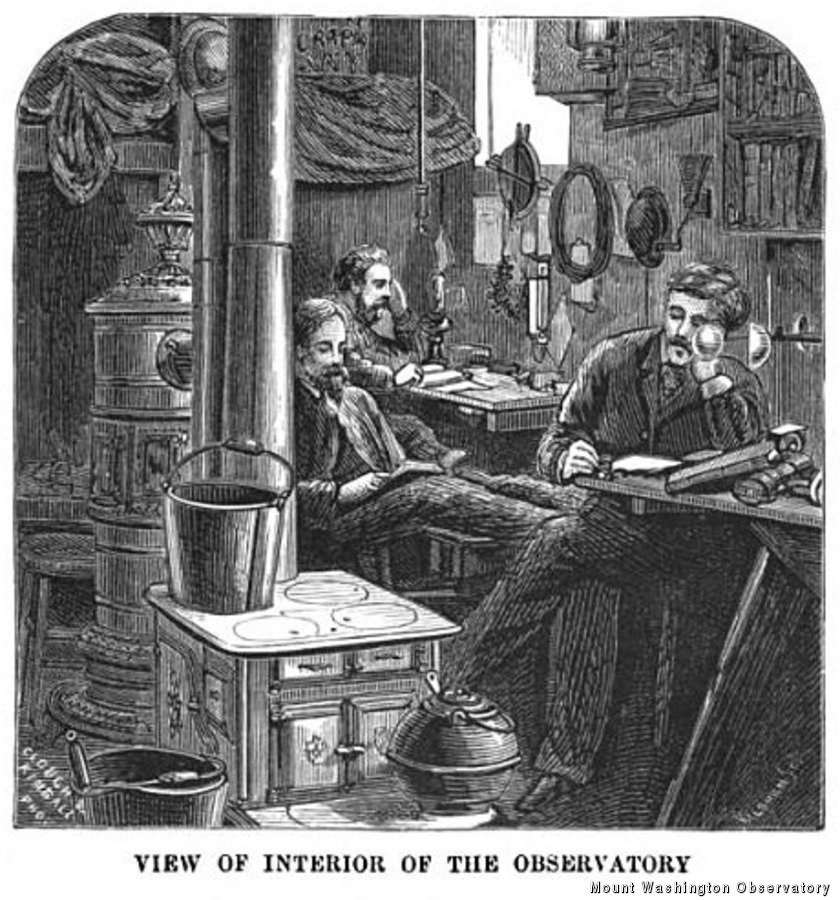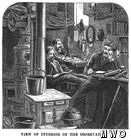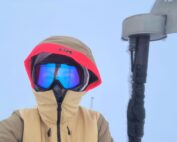The Wind Howls as We Stir the Pot
2014-01-28 12:06:00.000 – Dianne Fallon & Hilary Clark, Summit Volunteers
NULL
As I write at the kitchen table, a pulled pork lunch for 17 simmers in the crockpot and the wind shrieks above the stove vents. That wind has been howling for the past four days, hitting a peak gust of 121 mph on Sunday, when the temperature dropped to -25 and the wind chill was a crazy -76. And we summit volunteers are loving it!
The possibility of extreme weather is one of the main reasons why I signed on for the eight-day volunteer stint in January. I knew that extreme weather meant we wouldn’t do any real hiking, but I was okay with that, as I’m rusty on my winter hiking skills. I had the warm layers I needed to safely push myself into 100 mph winds, plus a pair of sneakers for indoor laps around the rotunda to get some exercise in between short jaunts outdoors.
My best workout of the week, however, came on Sunday, when I attempted to join the Century Club. To become a member, you have to make your way around the perimeter of the observation deck during sustained winds of 100 mph winds. You must remain upright and not hold onto anything. I made it standing up to the far side, but then I knew I was done, and began to make my way back to the tower in a sort of crab walk, with my back to the wind. The wind chill was -76, but I was sweating from the exertion. Although the 20-something observers made it much further, a 121 mph sent one of them flying about 10 feet.
After this exhilarating training exercise, I was ready to give it another go on Monday, when we had sustained winds in the 95 mph range, with 100+ mph gusts. This time, I employed the observer strategy of side-stepping to create a more narrow profile. Halfway around the deck, I had to stop to catch my breath, but I knew I would make it around. And I did, although it turns out the sustained wind was around 95 mph, with a couple of 100 mph gusts. Not quite a Century Club member, but now I am prepped for the next opportunity.
During my stay on the mountain, I’ve been reading about the winter of 1870-71, when State Geologist Charles Hitchcock and Assistant Geologist Joshua Huntington, along with three other men, and several visitors, spent the first winter on Mount Washington.
This scientific expedition set up shop in a small room carved out of the depot for the just-completed cog railway. They spent the winter doing weather observations, using some of the same instruments that the observers use today. They communicated to the outside world via daily telegraphs and were constantly heading out in extreme weather to repair the telegraph line.
During their first full-on winter storm, some time in December, the group spent a frightening night huddled around the coal stove, as they listened to the roar of the wind and wondered if their quarters would hold fast. The building, which was held down with chains, withstood the wind, and gave the group faith that they would weather future storms. Glass panes might shatter and they might have to stay up much of the night keeping the stoves going, but they could enjoy listening to howling winds rather than fearing them.
Hitchcock, Huntington and their companions each wrote different sections of Winter on Mount Washington, the 1871 book describing the expedition. The prose is dense, written in the leisurely 19th century style that can be tedious for modern readers. But what strikes me as I read about their days on the mountain is how little the winter experience has changed. Although the men lacked today’s comforts, they were perfectly cozy in their small quarters. They got up early and piled on their gear to watch the sunrise. They watched the clouds float up over Jefferson and Adams. They marveled at the sunsets over the Franconia Ridge.
In Chapter 11, ‘Life on the Summit,’ Joshua Huntington wrote,
‘Most persons suppose that life on Mount Washington in winter must be gloomy, and gloomy enough it would be, at times, when the summit is enveloped in dense clouds for weeks, if it were not for the cheering click of the telegraph instrument. They might suppose also that time would be extended indefinitely; that at night we should wish it was morning, and that in the morning we should long for night to come, and thus drag out a wear existence. If the time of any persons in excellent health is wholly occupied in a pursuit that is congenial they are rarely gloomy, and are almost unconscious of the flight of time. But here, besides good health and time occupied, there is an excitement found nowhere else.’
‘One gorgeous sunrise throwing a flood of light across a sea of clouds, one glorious sunset tingeing the clouds with crimson and gold, and the sun descends leaving the blush of day upon these snowy summits, or a storm unprecedented at lower elevations, infuse into our life enough that is grand and sublime to occupy the thoughts for weeks. With such surroundings, a person, on account of the intense excitement, may live too fast to have life extended to full three score years and ten; but there is a pleasure in it that would fully compensate for a few days cut off from the number to which life might be lengthened if passed in some quiet retreat, undisturbed by anything hat arouses the whole being, and carries the mind into ecstasies of delight. So days and weeks pass, and we are almost unconscious of the lapse of time.’
I couldn’t have said it better myself.
Dianne Fallon & Hilary Clark, Summit Volunteers
Supporter Spotlight: Ryan Shepard
Supporter Spotlight: Ryan Shepard By Ryan Shepard and Carissa Milliman Ever since I was a kid, living in Western New York and growing up with lake effect snow, I thought harsh weather was incredibly
Supporter Spotlight: Erik Rider
Supporter Spotlight: Erik Rider By Wendy Almeida For Erik Rider, supporting Mount Washington Observatory comes from a lifelong fascination with weather and how it shapes daily life. Growing up along the Massachusetts coast, he
An Autumn Above the Clouds on Mount Washington
An Autumn Above the Clouds on Mount Washington By Cassie Farnsworth I don’t know how many times in life you get to say “it was exactly what I hoped it would be,” but my




